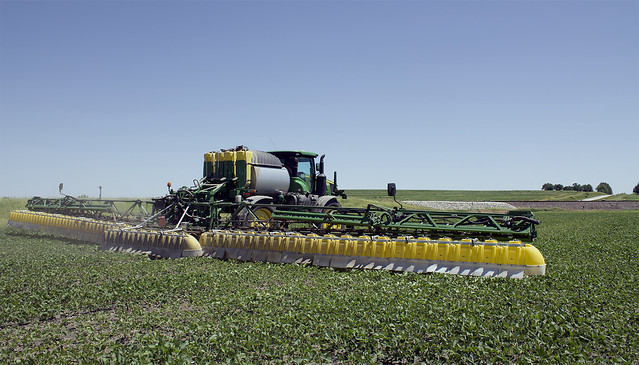Dicamba Update: Are Hoods the Answer to Drift?
If Steve Claussen had it his way, U.S. EPA would amend the dicamba label today to allow for spraying in higher wind speeds than the 3-to-10 mph range currently permitted – so long as a spray hood is used.

Redball SPK645 self-propelled broadcast retrofit hood kit in an Illinois soybean field. Photo courtesy of Steve Claussen
A hood, you say? “We try to keep chemical where it’s intended to be sprayed, in a simple and inexpensive way that just about anybody can understand. If you put a spray tip in an enclosure and spray, you’re eliminating wind and other things that can happen from Mother Nature,” says Claussen, Founder and President of Willmar Fabrication, maker of Redball sprayer hoods.
Down in southern cotton fields, they’re a common sight, but up North, spray hoods remain somewhat of a mystery to many growers.
Hoods take only about 10 minutes to put on and off, he says – but time is money. More to the point, there is no legal way in which to use hoods to see the clear benefits of reduced drift and improved deposition, as an applicator still has to abide by buffers and can’t spray if winds are stronger than 10 mph. In Canada and Europe, Claussen points out, credit is given to applicators that use hoods or shields in the way of a 70% to 100% reduction in buffers depending on the chemistry.
Claussen grew up on a Minnesota farm, not far from where he and his brother invented the Redball Monitor in 1983 for monitoring fertilizer. Soon after, they developed the Redball spray hood for pre-Roundup Ready cotton growers to fight weeds between rows. “Everybody in the South knows about Redball hoods, but up North, we never had the need or awareness, or any company to help us push it.”
Ahead of the release of dicamba-resistant technologies, Claussen sensed opportunity, knowing what he did about the molecule’s propensity to drift. He redesigned the company’s original hood with a goal of 100% drift reduction.
“I wanted to get where we could control all drift with the hood in all conditions. I’m not saying it does that, but it does it much more effectively than anything else on the market, from a consistency, day-in-and-day-out point of view,” he says.
In 2013, he took the hoods to Dr. Greg Kruger at University of Nebraska and Dr. Dan Reynolds at Mississippi State University, who undertook three years of studies using glyphosate, which yielded two papers, one published in 2014 and the other in 2018. The studies demonstrated that hooded sprayers “considerably reduced drift of all tested spray qualities at short distances downwind, including up to 86% less with a Fine spray quality. Additionally, at longer distances up to 300 feet downwind, both larger spray qualities and sprayer hoods reduced drift independently.”
He took the data to EPA, but that’s not all. He also dragged a sprayer boom, complete with hoods, along with him on the road to Maryland, just outside of D.C., to show the agency its powers up close and in person. “Fifteen EPA staff and managers came and we got their attention for four hours.”
EPA encouraged him to seek out the support of the dicamba or other pesticide registrants, at least one of which would need to make the request to change the label to allow applications with reduced buffers or higher wind speeds.
“We’re still trying to find the registrant or someone that wants to team up and jointly promote what the hoods can do, just like we did in the South” Claussen says. “Right now, it’s awareness as much as anything. With the awareness will come label changes, just like in Canada and Europe. It’s just a matter of where and when.”






